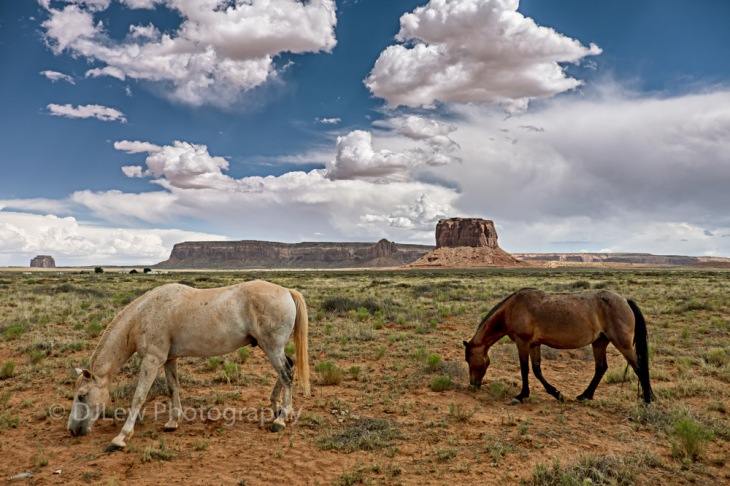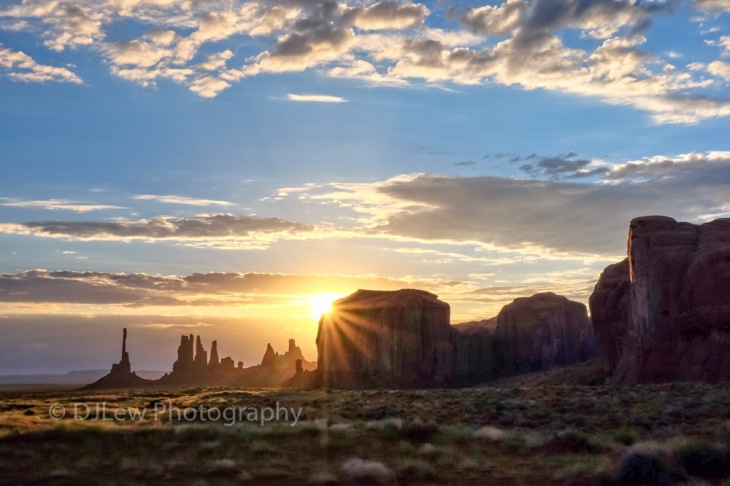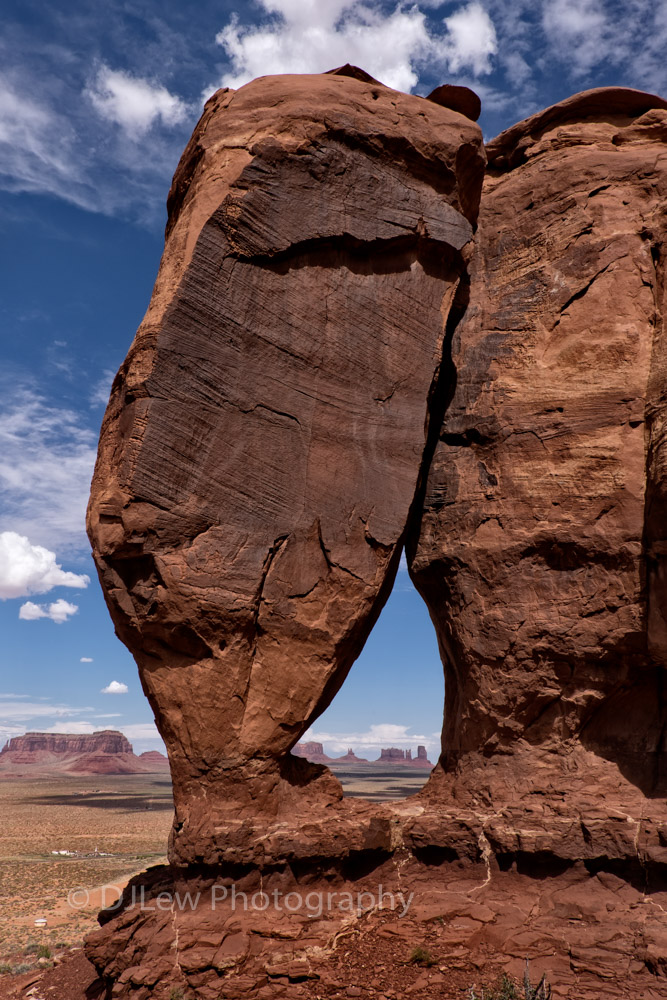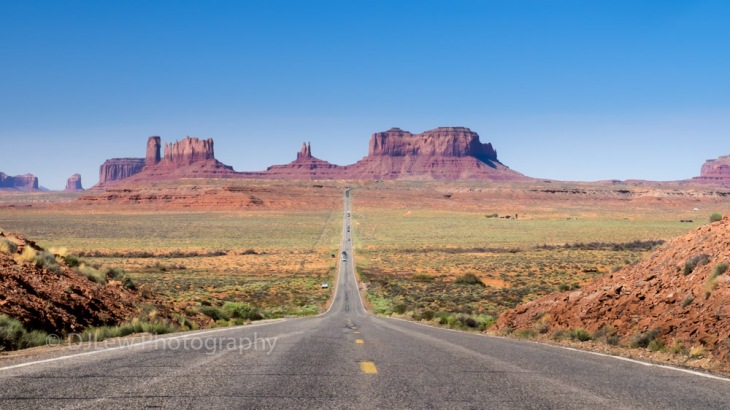
Classic valley scene of the West & East Mitten’s and Merrick Mesas (Spearhead Mesa on far right)
For years I’ve been telling myself “one of these days” after seeing TV commercials, print ads and movies featuring this part of the SW’n part of the US. For some, it’s the old westerns like Stage Coach or countless John Wayne classics, while for others it may be more recent favorites such as Back to the Future III or Forest Gump, whichever it inspires you to make the journey here … do it. Since I didn’t have much time, I hired a tour

Wild horses, God of Rain Mesa as the backdrop in the distance
company to take me around the valley for a day. Wait … where am I going? The majestic Monument Valley of the Navajo Nation or Tsé Bii’ Ndzisgaii (Valley of the Rocks). Everything has a price though. Before entering the official portion of the area (aka Monument Valley Navajo Tribal Park), there is a flat rate of 20$US. From there, you have full range of the valley – so long as you stay on the fairly maintained loop drive in the valley itself. Being that the loop is dirt … or rather sand, be ready for a filthy car afterwards. The fine reddish sand is from the surrounding sandstone

Ear of the Wind Arch
monuments that have eroded over the millenniums. Only about 5 square miles in size, there’s plenty to marvel on your own. Going it alone is perfectly doable, but if you really want a fuller more richer experience of the valley, you need to get off of the public loop and explore the more worthwhile monuments up close and personal – this is only accessible if you hire a Navajo guide and of course, means shelling out yet more money.

Let it rain!
From all public accounts, the atrocities that the “white man” put upon the Natives centuries ago far outweighs the reparations around the various tax-free liberties that have been granted to Native Tribes in the the USA. I fully support a small payment for anything on and about these proud people of North America. Firstly, I am genuinely interested in their culture of the past and present – asking even the simplest questions in their thoughts around how life is today. Being of Asian descent myself, over the years I’ve been asked

Micro-climates all around the valley over Sentinel Mesa
many things in what I would rather be called (as a ethnicity or bundled ‘race’ label) – everything from knowing that the word ‘chink’ is offensive to the more gray area of ‘oriental’. In my curiosity, I had a couple of opportunities to as what they (being of Navajo descent) thought of the proper way of addressing their race. I got a mixed response, but ‘Red Skin’ was not a good thing, ‘Indian’ was a gray area (dependent on age) and ‘Native’ was the most acceptable. Another thing I found interesting was one young Native’s opinion that the Native race as a whole likely came from western China (Tibet) during a mass migration to the North America; I have drawn a similar assumption in recent years during my travels to the Tibetan regions of China, but to hear this from a Native was a first! One thing was consistent was they acknowledged, appreciated and praised my asking the question in the first place. I guess you just gotta’ be sensitized to certain things without presumption, right?
Again, I digress … I found the only tour that included an overnight stay within Monument Valley itself (by a stroke of luck or mouse click as it were). Wayne, our drive and Guide throughout the valley was an interesting fellow with a storied past within and outside the Navajo Nation, but that’s another story in itself. Taking us off the public access roads for different views was worth it. We had a traditional Navajo Taco for dinner – which as a doughy round flat bread (flour) topped with beans, diced tomatoes, onions and your choice of meat poured over it. Not the most thrilling or exotic, but fulfilled the hunger. Speaking of hunger the image above (of the rainbow over

Big Dipper in full view
After dinner as the full moon began to rise, we huddled around in a semi-circle for a traditional Pow-wow. The beat of the drum and singing in Navajo tongue echoed in the bowl shaped mesa high above us all the while having an explanation of what each dance ritual was for. It was quite interesting the say the least. I bring with me wherever I go a small portable flash head (Fuji EF-X20) that works with both my Fujifilm and Nikon; it’s a tiny little block that’s packs a punch. It being dark now, flash was a necessity. Controlling

From inside a traditional Hogan (my abode for the night)
flash is an art form for sure – one of which I am learning every time I have the chance. I don’t use all the bells and whistles (aka automation) that TTL gives you as I’ve found better results in full manual mode. Doing close up work (within say, 10 ft), I try to not go above 1/16 power for both quality of light and output power as I just want to send out a”kiss” of light instead of blasting it and quicker refresh cycle (time it takes in between firings). I started out with the flash mounted on the camera – I knew this wasn’t going to produce great outcomes, but I had to try. One frame lit too much of the ground (I am

Sunrise over the famous Totem Pole
shooting low —> high) so I scrambled and ran for my remotes in the car. With transmitter and receiver, I am able to independently move camera and flash around randomly to achieve the right lighting angle. Last thing … it being dark out, autofocus was totally useless, so I just estimated the general distance b/n me and the dancer, flipped to manual focus, set the distance focus and shot away – kind of a set it and forget it thing. it worked like a charm!

Teardrop Arch with the Mitten’s in the background
After the Pow-wow, we head for the sleeping area in the valley that’s protected by 2 large mesa’s. We were given a choice to either sleep under the stars or in a Hogan – a traditional Navajo dwelling. I chose the Hogan … why not right? I can sleep under the stars just about anywhere. The Hogan was as basic as you can get – complete with dirt flooring. The Hogan is built in an octagon shape using skinny logs and covered in mud from the surrounding red, iron-rich sandstone dirt. It being a full moon, it was good and not so good. Good: nice a bright to light the valley up and night, not so good: doing star trail photography a virtual impossibility (it being too bright). Slept well as it as a full day of trekking around the valley (not to mention a 5+ hr drive up here from Phoenix).
The trek from the above Teardrop Arch wasn’t difficult, but not easy at the same time to get to – especially when it’s hidden from plain view from below the mesa in which it sits. I asked our tent site attendant how to get here. He said we can only get there by a Guide. As he tried in vane to find one, he finally said to just go up there yourself – not a common thing b/c it’s Navajo land saying that if we do find it, the fee would be $20 (the guided tour is $60). So, he drew a map, gave it to me and we were on our way. With plenty of water (it was around 98*f out in full sun) trekking across a couple of washes before having to scale up the side of the mesa some couple hundred feet high. Halfway along this dog came racing up and walked beside us for a while. Then, she began to lead the way. It appeared that she knew the way as she kept looking back at us as if to say, “well aren’t you coming?” I followed and she led us right to the arch! I had to reward her with half of my water as she was panting for water in the hot summer sun.
Gorgeous views, gorgeous people. I can now see why Hollywood is so enamored by the valley …

Run Forest Run!




Your pictures are beautiful!!!
LikeLike